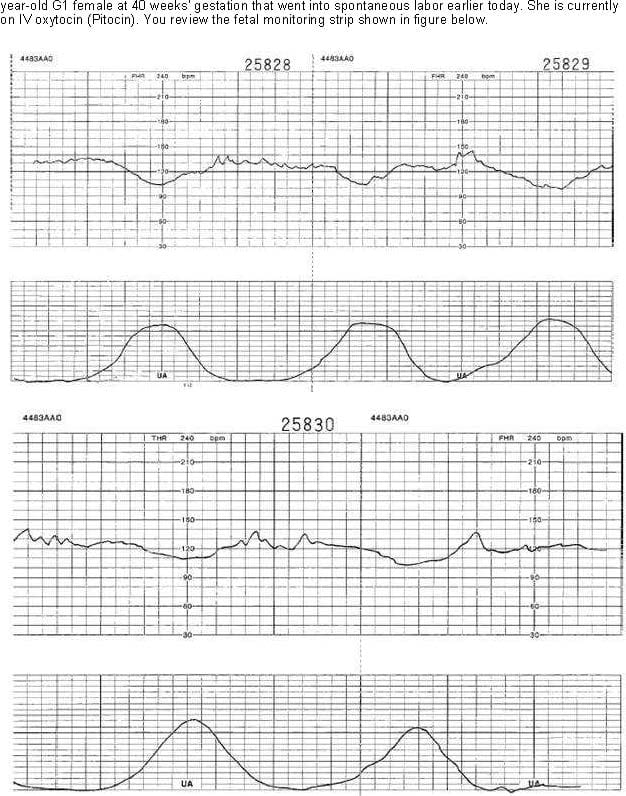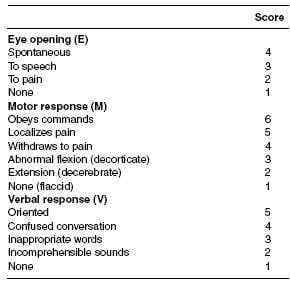USMLE-STEP-3 Online Practice Questions and Answers
A 32-year-old woman presents with complaints of irritability, heat intolerance, hyperdefecation, and frequent palpitations. She has lost 20 lb over the past six months. She has always been in good health and does not take any prescription or OTC medications. She denies any prior history of thyroid disease or exposure to head/neck irradiation, but she states that one of her relatives was diagnosed with a thyroid disorder at roughly the same age. Vital signs are as follows: BP 138/78, HR 112, RR 22, temp. 98.8°F. On examination, her thyroid is diffusely enlarged and smooth. Auscultation of the thyroid reveals a bruit. Her hair is fine in texture, and she has warm velvety skin. She has hyperactive deep tendon reflexes. There is a fine tremor in her outstretched hands.
Which of the following sets of laboratory results would be consistent with this patient's presentation?
TSH free T3 free T4
A. low lowhigh
B. low normal normal
C. low high high
D. highlow low
E. high high high
A54-year-old man without significant past medical history presents to his primary care physician complaining of epigastric discomfort and early satiety. He subsequently undergoes an endoscopic procedure revealing an ulcerated mucosal lesion. The biopsy of this lesion is interpreted as a well-differentiated lymphoma.
Which of the following statements regarding his treatment and prognosis is most accurate?
A. His prognosis is poorer than if he were diagnosed with a gastric adenocarcinoma.
B. This lymphoma is not associated with Helicobacter pylori infection.
C. Antibiotic therapy may induce regression of the lesion in the majority of cases.
D. Treatment will not offer curative potential, so he should be referred for hospice care.
E. Gastric resection is recommended for well-differentiated, bbut not higher grade, lymphomas.
A 4-week-old, previously healthy male presents with projectile emesis after feeds. His mother states that he has had 2 weeks of postprandial emesis, which became projectile in the past 2 days. She states that it looks like formula and has never been bilious.
Which of the following statements is true?
A. Physical examination is almost always normal in patients with this condition.
B. Upper gastrointestinal (GI) contrast study is the best diagnostic option.
C. This patient should be taken emergently to the operating room (OR) once the diagnosis is made.
D. If uncorrected, these infants will progress to complete obstruction.
E. Surgical therapy involves bypassing the site of obstruction.
A 30-year-old male is brought to the ED after being hit in the head by a baseball. He is making incomprehensible sounds, but no words. He opens his eyes and withdraws to painful stimuli. His Glasgow Coma Scale score is:
A. 10
B. 9
C. 8
D. 7
E. 6
Vital capacity is best described as the volume of air which is:
A. inhaled during normal respiration
B. expelled during passive expiration
C. remaining in the lungs after passive expiration
D. actively exchanging with pulmonary venous blood
E. able to be expelled following maximal inspiration
You perform an upper endoscopy on a patient and find changes suggestive of Barrett's esophagus. How do you explain this to the patient and his family?
A. Is a condition where the normal esophageal lining is replaced by columnar epithelium.
B. Is a condition where the normal esophageal lining is replaced by dysplastic squamous cells.
C. Two biopsies with histologic changes are needed to confirm the diagnosis.
D. The main risk associated with Barrett's esophagus is bleeding.
E. It is related to peptic ulcer disease.
A22-year-old nulliparous woman who desires future fertility is found to have a pap smear consistent with high-grade squamous intraepithelial lesion (HGSIL). The final pathology report indicates a single focus of squamous carcinoma invasive into the cervical stroma to a depth of 2.0 mm. An ECC is negative. There is no lymphvascular space invasion, and the cone margins are negative. The most appropriate therapy for this patient is which of the following?
A. radiation therapy
B. simple hysterectomy with pelvic lymphadenectomy
C. radical hysterectomy with pelvic lymphadenectomy
D. radical trachelectomy
E. observation with close follow-up
You are called by the labor and delivery nurse to evaluate the fetal monitoring strip of a patient. She is a 24

year-old G1 female at 40 weeks' gestation that went into spontaneous labor earlier today. She is currently on IV oxytocin (Pitocin). You review the fetal monitoring strip shown in figure below.
What fetal heart rate condition does this monitor strip reveal?
A. late decelerations
B. early decelerations
C. variable decelerations
D. hyperstimulation
E. fetal tachycardia
A 40-year-old male is returning to the office for a follow-up visit. He is told about his blood work results, which are consistent with leukemia. He is informed that he should receive a bone marrow biopsy for further clarification. While being presented with this information, he remains silent, peering, and staring intensely. When finished, he comments, "Doctors think they are so smart!" He then explains that he has been mistreated by physicians in the past and, in fact, has several malpractice suits pending. He feels that the biopsy was recommended only "because you want to use me in order to publish and further your career."
When interacting with this patient, which of the following approaches would be most effective?
A. defend the recommendation by citing professional credentials
B. encourage him to speak with a psychiatrist to provide added support
C. interpret his anger as a defense against his fears of having leukemia
D. provide detailed information regarding his differential diagnosis
E. refer him to a colleague to avoid litigation
A 30-year-old married male with a history of depression presents to the family medicine clinic. He appears embarrassed and somewhat anxious during his appointment. He denies significant sadness or crying spells. He is sleeping adequately and eating well, without recent changes in his weight. His energy and concentration are normal, and he denies any suicidal or homicidal ideation. He claims to be compliant with his citalopram (Celexa), which he is taking for his depression, but he complains of "problems with sex."
Consideration is given to switching the patient to another antidepressant in order to minimize his side effects. Which of the following would be the most appropriate medication to choose?
A. desipramine (Norpramin)
B. fluoxetine (Prozac)
C. mirtazepine (Remeron)
D. phenelzine (Nardil)
E. venlafaxine (Effexor)
A 68-year-old widow presents to the primary care clinic for a routine appointment. Her current medical problems include hypertension, obesity, and chronic obstructive pulmonary disease. She has no significant psychiatric history, although she saw a psychologist for eight sessions after her husband died. She does not drink alcohol or use illicit drugs. She has smoked one-and-a-half to two packs of cigarettes per day for the past 45 years and she wishes to quit. She has heard about some of the options but is unsure which would be the most effective.
After being informed of the various choices, she decides to proceed with medication. Which of the following medications is most useful for tobacco cessation?
A. bupropion (Wellbutrin)
B. fluoxetine (Prozac)
C. mirtazepine (Remeron)
D. trazodone (Desyrel)
E. venlafaxine (Effexor)
A42-year-old male presents to the office for a refill of the nasal steroid medication that he uses every spring to control his allergies. You notice on the vital signs taken by the nurse that his blood pressure is 150/95. Except for some sneezing and nasal congestion, the patient has no symptoms. He has no other medical history and his only medication is a nasal steroid. He does not smoke cigarettes, does not drink alcohol, and does not exercise. His body mass index is 24 kg/m2.
Of the options listed, which would be the most appropriate management at this point?
A. recommendation of a low salt diet and follow-up in 912 months
B. increasing the dosage of the previously started antihypertensive medication
C. initiating therapy with a calcium channel blocker
D. initiating therapy with a thiazide diuretic
E. initiating therapy with a thiazide diuretic and an angiotensin-converting enzyme (ACE) inhibitor
While you are working in the community health center, a 40-year-old male presents to you as a referral from the dental clinic. The patient reported on the intake history form at the dental office that he had rheumatic fever at the age of 7. The dentist refused to allow him to have a dental examination and cleaning until he was cleared by a medical doctor. Other than rheumatic fever, the patient has no medical history and does not take any medications. He denies chest pain, palpitations, dyspnea, or any other symptoms. On examination, he has normal vital signs and a normal general examination. On auscultation of his heart, you hear a 2/6 systolic ejection murmur at the left upper sternal border without radiation. Review of his chart shows that he had an echocardiogram approximately 9 months ago that revealed mild mitral valve prolapse without evidence of mitral regurgitation, but otherwise normal valves and cardiac function For which of the following cardiac conditions is bacterial endocarditis prophylaxis recommended?
A. cardiac pacemaker
B. isolated secundum atrial septal defect
C. previous coronary artery bypass graft
D. bicuspid aortic valve
E. the presence of any cardiac murmur
Which of the following statements regarding vaccinations of pregnant women is true?
A. Women who will be beyond the first trimester of pregnancy during flu season should routinely receive the inactivated influenza vaccine.
B. Pregnancy is an absolute contraindication to the hepatitis B vaccine.
C. Women who test negative for rubella at their initial prenatal visit should routinely receive a rubella vaccine during their second trimester of pregnancy.
D. Pregnant women who have not completed a Td primary series should start this series in the immediate postpartum period.
E. Women who receive a rubella vaccination within 4 weeks of becoming pregnant should be advised of the high risk having a baby with congenital rubella syndrome.
Ahistory of which of the following conditions would result in the greatest increase in the likelihood of developing colon cancer?
A. Crohn's disease
B. diverticulosis
C. hamartomatous polyp
D. pseudomembranous colitis
E. ulcerative colitis


